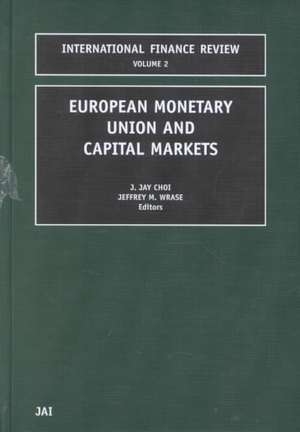European Monetary Union and Capital Markets: International Finance Review
Autor J. Jay Choi, J. Wraseen Limba Engleză Hardback – 12 dec 2001
Din seria International Finance Review
- 9%
 Preț: 938.91 lei
Preț: 938.91 lei - 9%
 Preț: 663.09 lei
Preț: 663.09 lei -
 Preț: 446.99 lei
Preț: 446.99 lei - 9%
 Preț: 627.02 lei
Preț: 627.02 lei - 23%
 Preț: 921.42 lei
Preț: 921.42 lei - 23%
 Preț: 1004.01 lei
Preț: 1004.01 lei - 23%
 Preț: 964.98 lei
Preț: 964.98 lei - 23%
 Preț: 1005.48 lei
Preț: 1005.48 lei - 23%
 Preț: 1050.92 lei
Preț: 1050.92 lei - 23%
 Preț: 1290.54 lei
Preț: 1290.54 lei - 23%
 Preț: 1118.54 lei
Preț: 1118.54 lei - 23%
 Preț: 1040.95 lei
Preț: 1040.95 lei - 23%
 Preț: 1149.67 lei
Preț: 1149.67 lei - 23%
 Preț: 995.64 lei
Preț: 995.64 lei - 23%
 Preț: 808.34 lei
Preț: 808.34 lei - 23%
 Preț: 745.04 lei
Preț: 745.04 lei
Preț: 994.54 lei
Preț vechi: 1291.62 lei
-23% Nou
Puncte Express: 1492
Preț estimativ în valută:
190.33€ • 197.97$ • 157.13£
190.33€ • 197.97$ • 157.13£
Carte tipărită la comandă
Livrare economică 15-29 aprilie
Preluare comenzi: 021 569.72.76
Specificații
ISBN-13: 9780762308309
ISBN-10: 0762308303
Pagini: 288
Dimensiuni: 156 x 234 x 19 mm
Greutate: 0.58 kg
Editura: Emerald Publishing
Seria International Finance Review
ISBN-10: 0762308303
Pagini: 288
Dimensiuni: 156 x 234 x 19 mm
Greutate: 0.58 kg
Editura: Emerald Publishing
Seria International Finance Review
Cuprins
Part 1: An Overview of European Monetary Union and Capital Markets. Monetary union and market integration: Capital and goods market issues pertaining to the launching of the Euro (J.J. Choi, J. Wrase). Part 2: Approaching Monetary Union in Europe: History and Foundations. Historical overview of the transition to monetary union in Europe. (K. Phillips, J. Wrase). An retrospective structural break analysis of the French German interest rate differential in the run-up to EMU (J. Henry, P. McAdam). Volatility and misalignments of EMS and other currencies during 1974-1998 (M.G. Papaioannou). Part 3: European Monetary Union and Capital Markets. The impact of the Euro on primary equity markets (E.K. Gatzonas). Country and industry effects in Euroland's equity markets (I.J.M. Arnold). Intra-day transmission of international stock prices (C.S. Eun, J.G. Jeong). Part 4: Monetary and Fiscal Policy Issues in the Monetary Union. Organization and policy procedures of the European system of central banks (J. Wrase). Monetary and fiscal policy rules in the European economic and monetary union: A simulation analysis (G. Haber, R. Neck, W.J. Mckibbin). Is there potential for monetary union outside Europe? (V. Hooper). Part 5: Trade and Market Power. Monetary union expansion: The role of market power in trade (M.M. Spiegel). The European monetary union vs. U.S.A, cooperation and competition: An examination of welfare benefits (L.B. Ramrattan, C.D. Tully, M. Szenberg). The Euro exchange rate and consumer prices (S. Ranki).
Recenzii
...Twelve papers explore the effects of the European Monetary Union (EMU) on capital markets, address monetary and policy issues associated with the EMU, and consider microeconomic effects of monetary union on trade, pricing, and resource flows.
Journal of Economic Literature, 2002
Journal of Economic Literature, 2002



















